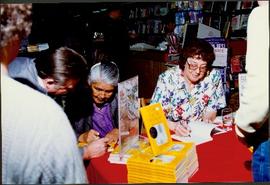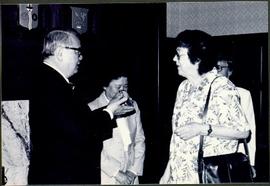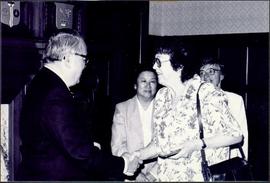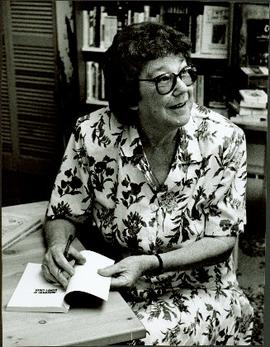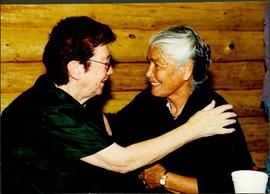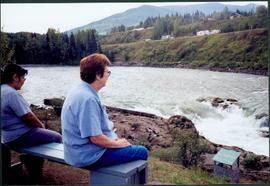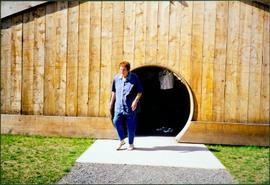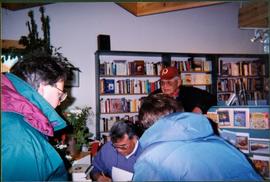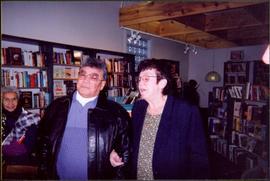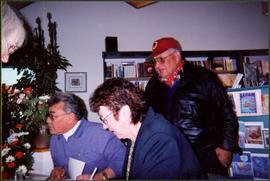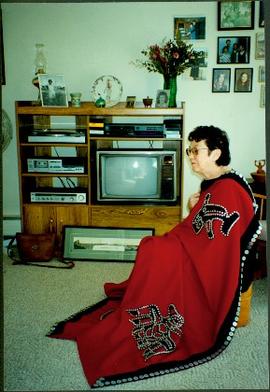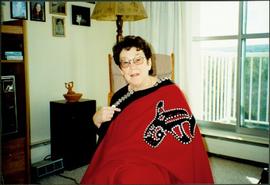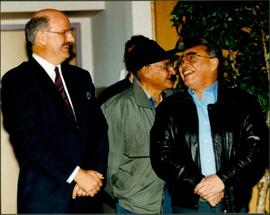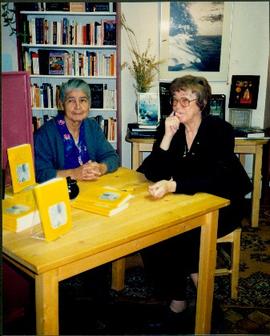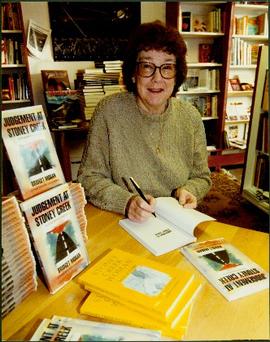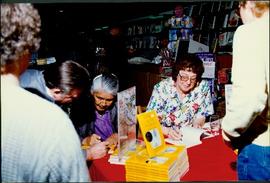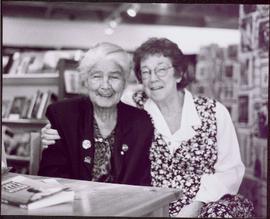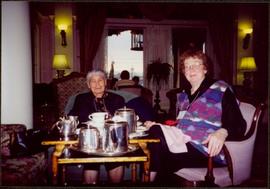Photograph depicts Mary John seated to left of Bridget Moran at book signing table. Copies of 'STONE CREEK WOMAN' displayed in foreground. Three unidentified individuals stand gathered around table. Bookshelves and computer in background. Accompanying photo caption reads: "Autographing - Woodward's - May 27/89. Taken by David Mah."
Handwritten annotation on recto: "His Honour David C. Lam congratulates Bridge Moran of Prince George for her award winning book - Stoney Creek Woman." Lieutenant Governor Lam stands in formal attire on left, presenting medal to Moran. Two woman stand in background.
Handwritten annotation on recto: "Bridget Moran receives the Lieutenant - Governor's Medal for Historical Writing from His Honour David C. Lam in Government House, May 12, 1989." Lieutenant Governor Lam stands in formal attire on left, shaking hands with Moran. Two woman stand in background.
Photograph depicts Bridget Moran seated at table with copy of her book in hand. Bookshelves visible in background.
Close view of Bridget Moran seated to left of Mary John, both with a hand on the other's shoulder. Log wall in background.
Photograph depicts Moran seated to right of woman on bench in foreground. Waterfall area at Moricetown Canyon can be seen below, behind booth labeled "MONITER BOOTH". Highway and houses visible on opposite shore in background.
Photograph depicts Moran walking away from round entrance to long house, unidentified individual visible inside.
Photograph depicts three unidentified individuals gathered around Justa Monk as he signs a copy of 'Justa: a First Nations Leader'. Plants and bookshelves in background.
Photograph depicts Justa Monk and Bridget Moran standing in bookstore. Unidentified woman and bookshelves in background.
Photograph depicts Justa Monk and Bridget Moran seated at table, signing copies of 'Justa: a First Nations Leader'. Plants, bookshelves, two unidentified individuals also visible in image.
Photograph depicts Moran seated in chair at unknown location. Red and black button blanket features traditional thunderbird and killer whale designs. Television against wall in background.
Photograph depicts Moran seated in chair at unknown location. Red and black button blanket features traditional thunderbird and killer whale designs. Television, armchair, and window visible in background.
Photograph depicts Justa Monk standing to right of Premier Harcourt in unknown room. John Alexis can be seen between them in background.
Photograph depicts Mary John seated to left of Bridget Moran at book signing table. Copies of 'STONE CREEK WOMAN' displayed in foreground, plants and bookshelves in background.
Photograph depicts Bridget Moran seated at table covered with copies of 'Judgement at Stoney Creek'. Three copies of 'Stoney Creek Woman' are also displayed on table. Bookshelves in background. Photo believed to have been taken at same location as items 2008.3.1.17.1, 2008.3.1.17.2, and 2008.3.1.19.4.
Photograph depicts Mary John seated to left of Bridget Moran at book signing table. Copies of 'STONE CREEK WOMAN' displayed in foreground. Three unidentified individuals stand gathered around table. Bookshelves and computer in background.
File consists of:
- Newspapers (all dated 1976) include: The Times; The Citizen; The Sun; The Vancouver Sun; The Nechako Chronicle; Maclean's magazine
- Report titled: "A visit to Vanderhoof and Stoney Creek Reserve" by Remi J. De Roo, Chairperson, Human Rights Commission of British Columbia, September 24- 25, 1976
- Incomplete copy of "Departmental policy - resource implications manpower services to Native people" from P.S. Hall, Branch Manager CMC Vanderhoof to W.F.J. Osborne, Sr. Manager, CMC Prince George, dated July 20, 1976.
- Handwritten draft (?) of "Specimen Form of Verdict" supp.1/15/69
- Excerpt from article published in "Politics: National Indian Brotherhood"
- Report: "Inquest of Coreen Thomas, Vanderhoof, B.C. September 25, 26, 27, 28, 1976" submitted by Barbara Kobierski, Native Programs Section, Legal Services Commission.
File consists of a newspaper article: "Farm mishap kills doctor" (June 21, 1989).
File consists of annotated transcript of interviews between Bridget Moran and Justa Monk.
Photograph depicts Moran with arm around Mary John, both seated at book display table. Bookshelves in background.
Photograph depicts Mary John seated to left of Moran at table in large room with tables, chairs, and couches. Skyscrapers visible through window in background. Accompanying note reads "Tea at the Empress! Feb/97"
Item is a recorded audio interview with Justa Monk.
Audiocassette Summary
00’10” Bridget Moran interviews Justa Monk. They discuss the ancestry of his last name and its original spelling, Monck. Moran wants to know more about Monk’s genealogy. She tells Justa his family history will be a chapter in the book.
08’ 45” Justa discusses how his ancestors move around on the land for hunting purposes. Moran wants to know more about gardens.
10’ 19” The interview returns to Justa’s family history, particularly the arranged marriage between his mother and father.
12’ 33” Moran asks about Justa’s immediate family. Justa talks about his brothers and sisters.
16’ 54” Justa talks about alcoholism with his brothers and sisters, and with other families.
20’ 10” Moran returns to asking about Justa’s brothers and sisters. Justa talks about one of his brothers being shot and killed; mentions the name of the man who killed his brother. Justa talks about his nephew getting shot by the RCMP.
27’ 54” Moran asks Justa about the relationship between him and his siblings. He talks about being the one who is reliable; has strong leadership skills, even though he is the youngest child.
30’ 50” Moran asks about Justa’s mother. She loved going to potlatches, did a lot of sewing. She was a very quiet and religious person. Justa’s father was the same, very outspoken. Justa tells Moran he is close to all of his brothers and sisters after she asks which he is closest. When Justa was 5 years old, he spent a lot of time with his father, where he learned to hunt by the age of 7.
34’ 20” Moran asks about Justa’s housing when he was growing up. He tells her his family had a large house, but there were no bedrooms, so they had different corners where they would sleep. They had a large garden outside of their home.
39’ 20” Justa talks about how isolated Portage was, so they had to grow their own food.
40’ 41” Moran asks about churches. Justa tells her there was a church and a priest came into Portage once in a while.
41’ 10” Moran asks about what Justa remembers about Christmas. He remembers getting dressed up and going to church to sing hymns.
43’ 02” Moran asks Justa which of his brothers and sisters went to school. Justa says his sisters were not punished or abused. His brothers enjoyed school. His brothers and sisters were not allowed to speak their language, and this was their only disappointment. Justa talks about his experiences at school; he quit school and tried to get a job.
50’ 24” Moran asks about when Justa moved from Portage to Tachie.
52’ 34” Moran asks about Justa trying to get a job at such a young age. He got a job with his brothers at a sawmill in Fort St. James.
55’ 33” Justa says he was born in 1943. Moran asks about when he met Theresa, his wife. They began their common-law relationship in 1966.
57’ 13” Moran asks about how long Justa was in jail. He served 9 months and was released on parole.
1:02’ 53” Justa talks about being unemployed and broke. Theresa came to visit him at camp where she stayed for 6 or 7 months. He talks about getting married later on in their relationship. Moran asks about where Theresa is from. Theresa is from Tachie but he did not know her growing up. Moran asks about Theresa’s background.
1:08’27” Justa talks about his many girlfriends, partying, and being a womanizer. Theresa and him got ‘serious’ after she had their daughter.
1:11’ 24” Moran ends the interview. She tells Justa they will change the pace for the next interview by discussing land claims. Moran asks Justa about running for chief. He lost the first time he ran.
1:14’28” Moran asks Justa about Kemano. Back in 1948, Kemano I was created. The Indian Agent came to the reserves for signatures so the Kemano project could go ahead. Justa says the people did not have time to move their things when the flooding began. People were misled with regards to what the Kemano project was about. People on the reserves were moved to Grassy Plains – they were spread out, not the same community as they were. In 1982, First Nations people began to fight back against Kemano II. Justa was a district chief.
1:24’ 48” Justa discusses the need for an environmental assessment for the Kemano project. The case to the Supreme Court and are currently waiting for the decision. The provincial government claims there is no need for environmental assessment and are planning to go forward with the project. Justa discusses the commission and the Kemano case, in general.
1:30’ 07” End of tape.
Item is a recorded audio interview with Justa Monk.
Audiocassette Summary
00’ 10” Justa talks about getting together a memorandum of understanding regarding boundaries for fishing grounds. Justa has also been discussing land claims with the provincial government. He talks about setting up the future for the younger generation. He says a fair land claim settlement would be the granting of traditional grounds.
5’ 27” Moran asks about the Save The River campaign.
6’ 14” Moran inquires about the diaries Justa is supposed to bring her. Justa wants to talk about his childhood. He feels his youth was better than the youth of today because they are given everything.
11’ 06” Moran asks about Justa’s life in Portage and to describe a day he remembers from his time there before going to residential school. He talks about not being allowed out after dark and being respectful of other people’s property. He discusses being disciplined by talking about what was right and wrong.
15’ 15” Justa talks about his time in residential school and how he was not allowed to speak his native language. He was shocked by the corporal punishment. Moran and Justa discuss about putting this in the book or not. He talks about not having any privacy in the residential school.
21’ 55” They return to discussing the personal details of Justa’s life in Portage, such as eating porridge for breakfast. Moran and Justa discuss fishing and hunting, and the times of the year he would be away from home.
27’ 55” Moran asks Justa about a day at the residential school. He talks about how he refused to buy a Bible. He participated in sports in his second year. He talks about the food and having to take cod liver oil. He talks about being a hockey player. He talks about the time he broke his leg at the residential school.
37’ 51” Moran asks Justa about which of his sisters would be willing to talk to her. They begin to talk about Justa’s philandering and how he had a lot of fun during that time. He talks about cheating on Theresa, but they stayed together. They continue to talk about his sex life. He talks about his relationship with Theresa. He talks about his daughter, Sharon.
47’ 00” Moran wants to talk about the trauma of John, his brother who was murdered. He tells Moran that was the time he started to turn his life around. They talk about his time in jail.
48’ 18” Moran starts the interview with Theresa, Justa’s wife. Moran asks Theresa about her personal details. She talks about her family past. She got married to get away from her parents, who were her adoptive parents.
52’ 40” Moran asks Theresa about going to residential school and how her parents would not allow it because they wanted to teach other responsibilities. Theresa talks about how some of her responsibilities were hunting beavers.
59’ 30” Theresa starts talking about how she found out she was adopted. She discusses her real brothers and sisters and how several of them passed away from tuberculosis. She talks about how she is close to her adoptive mother. Theresa does not know why she was adopted out.
1:05” 57” Moran asks Theresa about residential school. Theresa says she could not speak English, so was punished for speaking her native language. She says there was no corporal punishment against her. She talks about getting tuberculosis and getting transferred to a hospital where she stayed for eighteen months. She learned how to speak English while at the hospital.
1: 14’ 57” Theresa talks about getting married at the age of 18 in 1948. Theresa gets tuberculosis again in 1956, so was placed in a sanatorium. She returns to talking about her former husband and how he treated her poorly. He was sent to jail for about two years for assaulting Theresa.
1: 26’ 50” Theresa talks about how difficult it was to obtain money for her and the children.
1: 27’ 54” Moran asks about how she met Justa. She says she always liked him and thought he looked cute. She began to go out with Justa in the 1960s. She moved to Dawson Creek to be with Justa when he was released from jail.
1:33’ 35” End of tape.
Item is a audio interview recorded by Bridget Moran with Justa Monk's family members.
Audiocassette Summary
00’ 05” Moran is talking to Justa’s sister, Adelle. She says the old way of life is better than life today. They talk about the lack of gardens in Tachie today.
02’ 45” Adelle talks about the family history, particularly her father. She talks about their way of life when they were children. Adelle continues to talk about her past.
08’ 40” Adelle talks about the residential school and how she was upset she was when she was sent there. She talks about being punished for speaking their native language. She was at the residential school until the age of sixteen.
12’ 13” Moran asks Adelle about what she remembers about fishing. She talks about the process of fishing.
13’ 22” Adelle talks about her individual history. She talks about not getting married at all because she could not marry the man she wanted. She talks about getting tuberculosis and being in the hospital for a year. When she was released from the hospital, she moved in with a man who was abusive towards her. She talks about leaving him and moving to Prince George, eventually.
18’ 56” Adelle talks about how it was beneficial that her parents were strict. She continues to talk about her childhood, particularly Christmas.
24’ 36” Moran and Adelle talk about when Justa killed his brother. Adelle tells Moran that Justa looked after his brother’s children after he was released from prison.
26’ 08” Moran asks Adelle about whether she drank or not. Adelle says when she moved to Prince George she began to drink heavily.
27’ 35” Moran asks Theresa about the time her and Justa got married. Adelle tells Moran that Justa was the baby of the family and how his siblings ‘babied’ him, hence why his mother was so upset when he married Theresa.
31’ 00” Interview changes to Theresa’s mother. Theresa’s mother speaks in her native language most of the time and Theresa translates. They talk about her past, particularly where and when she was born. They talk about how many families lived in Tachie.
40’ 13” Moran asks about whether Theresa’s mother went to Fort St. James often before the road was built. When they went to Fort St. James, by horse, they would buy some groceries.
43’ 04” They continue to talk about Theresa’s mother’s past.
47’ 33” Moran interviews Jimmy, Justa’s brother. She begins by asking him with the road being built. He tells her life was better in the old days because it was cheaper.
50’ 10” Moran asks about the family history. Jimmy lists the siblings from oldest to youngest.
52’ 05” Jimmy tells Moran that he did not go to the residential school because his grandfather would not let him. Jimmy needed to work for the family because he was the oldest. He talks about everything being done by hand.
58’ 00” Moran asks Jimmy about the type of house that his parents lived in when he was born. He talks about his childhood and his way of life. He talks about helping building a house with his father that had no rooms.
1: 02” 53” Moran asks Jimmy when he got married. Jimmy talks about his wife’s family, particularly his father-in-law, who Justa was named after.
1: 04’ 58” Moran asks Jimmy his memories about living in Portage. He tells her he was a bad kid. He also talks about the trips he took to the surrounding areas. He tells her it was a hard life, but there were good things.
1:10’ 35” Moran asks Jimmy about any memories he has of Justa as a kid. Jimmy tells her that even as a kid, Justa was pretty smart. Jimmy would take him to collect hay. Justa was called the baby and was spoiled too much.
1: 13’ 09” Moran asks Jimmy where he was when Justa got in trouble with his brother. Jimmy said he had a feeling something bad was going to happen, so decided to go home. He talks about when he was told about the murder. Moran continues to ask about the situation, but Jimmy tells her he is still not sure what happened between Justa and John.
1:25’ 03” Jimmy talks about making his store bigger at the pressure of Indian Affiars, but it was too much to keep operating, so now there is only a store that sells junk food.
1:28’ 47” Jimmy talks about the loss of two of his children. He continues to discuss his children.
1: 34’ 36” End of tape.
Item is a audio interview recorded by Bridget Moran with Justa Monk.
Audiocassette Summary
00’03” Moran asks Justa how the Department of Indian Affairs party went at Other Art Cafe.
01’20” Moran tells Justa she has a number of questions regarding his political career. They talk about the number of bands in the area.
05’ 11” Justa talks about the nomination process for becoming tribal chief at the annual Assembly. He talks about when he was nominated and how he believed that he was nominated based on his character. Moran asks about the culture surrounding the Assembly, including entertainment. Justa tells her he did not participate in any of the activities.
12’ 41” Justa talks about his mother loving potlatch.
14’ 35” Moran asks Justa about the personal qualities it takes to be tribal chief. He tells her he was nominated because the people knew and trusted him.
16’ 03” Moran asks Justa about the role he played in getting the Department of Indian Affairs shut down. He tells her about leading a mandate to close the Prince George office through lawyers and the support of his people.
25’ 18” Moran asks Justa about the development of a school board for the reservations. He wants the school curriculum to teach the language and the culture. He has negotiated with the federal and provincial governments to implement these plans.
29’ 13” Moran asks Justa about his role in land claims. Justa talks about negotiating with the government to get some of the land back to his people. He has played a big role, he says, because he knows the area, the language, and the people. He talks about the long, drawn out process of planning the land claims concerns. Justa has a mandate as tribal chief to address land claims. He says the important part of the process is educating the people, white and non-white.
45’ 49” Moran is talking about Alcan locating grave markers to compensate for the damage done from the original Kemano project.
47’ 47” Moran asks Justa the role he has played in the Kemano II Project. He tells her that he took a big role because he saw the way of life being destroyed, never mind the environmental damage. He says he hates the concept of the project. Justa talks at length about the politics surrounding the Kemano II Project.
1:07’ 55” Moran asks Justa about which politicians he has met in his time as tribal chief. She encourages him to drop names. He lists a number of provincial and federal politicians.
1:10’ 45” Moran asks Justa about the Oka situation and any role he played in helping to negotiate the situation. He talks about an emergency Assembly. He discusses supporting the situation and telling his own people that they should not protest with the people from Oka to maintain peaceful land claims negotiations. He says he had to keep things calm in his own territory while offering support.
1:13’ 30” Moran asks Justa about the referendum regarding self-government. They talk about which way they voted.
1:16’ 20” Moran asks Justa about the consecration of the graveyards that were flooded by Kemano. He talks about how emotional the ceremony was and how much it hurt to be treated like second-class citizens. One woman described it as being chased out like a pack of coyotes.
1:19’ 50” Moran asks Justa about running for tribal chief again because he has unfinished business with the Kemano II Project.
1:20’50” Moran talks about the chapters of the book with Justa. They discuss some of the stories Moran is writing within the book.
1:28’ 42” End of tape.
Item is a recording of an audio segment from CBC Radio in which CBC Reporter Karen Tankard provides a documentary report on the CBC Radio program Daybreak on conditions on the Stoney Creek reserve, outside of the farming community of Vanderhoof, 15 years after the inquest into Coreen Thomas’ death in Stoney Creek, BC. Tankard interviews community residents about the inquest and discusses the state of racism in the town of Vanderhoof, BC in 1991 and concludes improvements have not been made.
Audiocassette Summary
Scope and Content: Tankard recalls that Maclean’s Magazine had written at the time of the inquest that “Vanderhoof was one of the most racially prejudiced towns in BC”
Tankard recalls Inquest of Coreen Gay Thomas’ death and includes archived interviews from the 1976 inquest. One Vanderhoof woman says people are putting “racial connotations’ around what is going on in Vanderhoof and that she has ‘many friendships’ with native people that ‘is not unusual’ While Minnie Thomas, a Band Councillor in 1976, discusses how poor white-native relations are on reserve and criticizes the state of housing and the economy on the Stoney Creek reserve
Tankard then talks to students at a dance on the reserve on Sept 15, 1991; she notes there is no high school for the native students. Native student Kevin Prince notes that “white kids don’t like native kids…”
Jackie Thomas who works at the Band Office states that the feelings of racism still exist here in 1991 Yet Vanderhoof Alderman Jack French states that he “doesn’t see it” in Vanderhoof now. Tankerd notes that Native people recall that the Inquest “shamed” the federal government into making some changes – some municipal services now exist and roads are paved in Stoney Creek, yet there is still 80% unemployment and a rise in drug and alcohol abuse. Gordon Smedley, editor of the Nechako newspaper discusses white-native relations 15 years after the inquest – and argues that a ‘core group’ of drug users impacts the image of natives in the community
Stoney Creek Elder Mary John argues that racism still exists and refers to how in the case of one native woman, who was a university graduate that she could not get even a clerical job in Vanderhoof
Vanderhoof resident Hugh Millard – argues that native residents from Stoney Creek are “not hampered by prejudice, but by a lack of education”
Bruce Smith, high school principal, expresses the challenges of keeping native kids in school; that activities have focused on liaison work with the Band. Smith notes the creation of the Yinka Dene Language Institute as means to keeping native students in school - seen as a ‘storefront’ school for adult education
Tankard notes RCMP also attempting to make changes and have hired a native constable
Yet Alderman Jack French notes there is not a lot of contact between the municipal council and the Stoney Creek Band Council – however argues that the municipality has avoided getting involved in such issues – “not our mandate” – the municipality’s mandate is to provide municipal services only.
Tankard recaps the findings of the Inquest – and questions if anything has really changed in Vanderhoof and Stoney Creek since the inquest.
While she recalls that Richard Redekopp was charged with criminal neglect that resulted in Thomas’ death – that due to a lack of evidence he was not convicted
Tankard surmises that perhaps the hope of the inquest that a reunion of white-native community in Vanderhoof and Stoney Creek was ‘too much’ and ‘unachievable’
End of documentary report by Karen Tankard
The Daybreak female radio broadcaster (unidentified) then invites Talk Back listeners to call in on the issue…..
End of tape
Audio recording consists of an interview conducted by Bridget Moran with Mary John.
Scope and Content: Continuation of Accession #2008.3.1.211.1 - Tape #1 & 2
00’02” Mary John continues to discuss their winter camp at Wedgewood; recalls being by herself in the shack; describes the camp; stove; and baking bannock
4’00” Mary describes winter at Wedgewood ; then would return to Stoney Creek
5’00” Mary describes Christmas; they never had turkey, a Christmas tree or presents because they had little money. Yet everyone came together and went to church
11’00”-16’00” Mary shows Bridget how to tan hides and use of oils for tanning and talks about teaching her children how to tan hides and talks about her children
16’00”-20’00” recalls more of how long they would stay at Wedgewood; talks about the village c.1930s; and the Indian Agent
20’00”-22’00” Bridget asks Mary about cases of tuberculosis; how many cases there were in the early days; she recalls working for one white woman and she bought a coat with a fur collar that costs $13.00; also working for Mrs. Silver c.1927
23’00” Bridget asks her about their camp in Vanderhoof; Mary recalls they camped in tents when they went to Prince George; many times went by horse.
24’00”-26’00” Marcy recalls traveling to Shelley for a potlatch and to put up a tombstone for a relative; and then traveling to Fort George. Mary describes traveling to Shelley to the Indian Reserve at one time for a week; memories of people and relatives there and at Fort George
27’00”-28’00” Bridget asks her about the purpose of a potlatch; She describes that it is somewhat of a “gathering” same as for white people, Bridget notes a potluck supper. Mary describes food at a potlatch; memories of people and relatives at Shelley
30’00”-36’00” Mary states she married Lazare John on June 11, 1929 when she was 16 years old; Mary describes the wedding; and the watchman arranging the wedding. She explains that the watchman was like a councilor who looks after the wedding; a heredity chief appoints them (Bridget mentions her tape recorder had been stolen so is asking again about when they were married). Says she did not know her husband before her wedding. Mary talks about her husband’s family; and also her thoughts about getting married so young and with no knowledge of men.
36’00”-37’00” Briefly talks about her thoughts on sex
38’00”-41’00” Talks about early married life with in-laws close-by; no privacy
42’00”-44’00” Talks about racial problems she experienced; her father was a white man
44’00”-46’00” Living conditions for Mary John; poor relationship with mother-in-law; Mary wanted to have her own house
End of tape
Audio recording consists of an interview conducted by Bridget Moran with Mary John.
Audiocassette Summary
Scope and Content: Tape recording is an interview between Bridget Moran and Mary John – a continuation of interviews.
Side 1
0’02” Bridget asks Mary when she quit smoking - in 1972
1’00” Mary notes there was no talk of sex life; not part of First Nations culture
2’00” Mary talks about when she started working at the hospital; she was able to save money and her husband drove her back and forth; lived in a tent to save money; they pumped water to drink from a well 1 mile away so that they did not get sick; she notes she began working at hospital after her husband lost his seasonal job
5’00” Mary notes they had to have a tribunal hearing to get old age pension for her husband because his birth was not registered
7’00” Mary recalls that the Depression did not hit reserves as hard as white people because ‘they had always been poor’; yet at that time they were never without food. She talks about tough times during the Depression – could not find work only relief; got used clothing from white people
10’00” Mary refers to a Mrs. Campbell, a white woman who was a widow and had small children who was also poor in the Depression and showed her how to repair socks
12’00” She notes that they did not have much of a relationship with the Indian Agent – they knew he existed but they did not see him much; viewed him as a representative for the Indians; some [of the Indian Agents] were good and some were bad; she describes difficulties with the Indian Agent and getting little food: only a single ration (24 bag of flour; 5 lb bag of rice, bag of salt; ½ lb tea and 2 lbs lard) to last a family for a month and also flannelette material to make bed clothes. Indian Agent Office was in Vanderhoof
17’00” Mary recalls that the watchmen quit in the 40s – that is when marriages stopped being arranged; there were no Band Managers then; that only ‘started recently’
19’00” Mary talks about the priest who lived on the reserve in the 1940s; she does not know whether the [Catholic] Church was good for her people. Does not think that the Catholic Church was good for Indian Culture – they were the ones that ‘took it away’ […] tried to beat it out of the children
24’00” She notes that since that time she has been asked to teach dancing and classes in Indian culture; notes that some children can speak “Indian” in Mary’s family; notes her children can speak their own language
27’00” Mary talks about when the residential school Lejac closed; that it was taken over by the Department of DIA
29’00” Mary sees ‘Alcohol as the worst problem among First Nation’ – she recalls that a group of them began to get together to ‘pray and work with people who needed the most help’; she notes that while native people were not allowed to buy alcohol before and now have the right to get it - it has since become a problem; she describes the effect of alcohol on the community. She notes that although she and her husband did drink at one time she doesn’t anymore and recognized it as a problem back in the 1950s. She describes her feelings after a nephew was killed in an alcohol-related accident and how this convinced her to quit drinking; it was a choice she made on her own
40’00” Talks about early years when they were married and how difficult life was at that time; she recalls going to see the children at Lejac and camping out to visit them; she describes how to make a camp with spruce boughs and bringing food to camp
45’00” Describes the furniture and stove they had in their house when Ernie (son) was born A lot of time spent with one another for recreation
(Continuation on side B – labeled as #6)
Side 2
48’00” Mary John talks about the church priest – would not come out every Sunday for Mass – only started recently having mass frequently; talks about the hospital where nuns worked;
56’00” Bridget asks her about recreation on the reserve; Mary talks about clothing used on sports team – played Stellako and other reserves; “Baseball was popular” – hardball; she recalls going to Prince George to watch ball tournaments
60’00” Discusses recreation in early years; would have dances at people’s houses
62’00” Mary discusses white-native relations; ‘we never talked about it’ there were white people who were ‘good people’ that she did work for; cases of racial tensions in Vanderhoof
67’00” Bridget asks her if any white people ever came to visit her home; Mary notes that none came out to the reserve – the only one that use to come out was the priest and remembers the priest eating breakfast at her home. But “Prince George wasn’t like that” She tells of racist comments even now that she experienced with a new doctor in town
End of session – tape ends temporarily Start up of session again
74’00” Mary John talks about their efforts to educate and pass on their culture to younger generations; they now teach survival in the bush. She explains that this is to get native youths to experience being in the bush and teach them how to prepare food at camp; how to prepare fish and smoke fish. She talks about the location of the survival camp, close to Wedgewood; “sometimes would have close to 12 students”
End of session – tape ends temporarily Start up of session again
83’00” Mary talks about Aunt Mary Sutherland. Bridget asks about Mary’s husband [Lazare] his family history.
88’00” Bridget asks Mary about the history of Stoney Creek Reserve; Mary then proceeds to note the names of the families who lived at the reserve. She notes that she was originally born at Fort George. They talk about an Indian Agent in the 1950s and the building of houses on the reserve
92’00” Talks about family logging business
End of tape
Audio recording consists of an interview conducted by Bridget Moran with Mary John.
Audiocassette Summary
Side 1
0’02” Improvements within the Department of Indian Affairs; she notes that Indian Affairs was tricking the band. The Indian Agent took a logging contract away from Mary John’s son Ernie because he refused to pay the rate that they wanted in stumpage fees
4’00” Mary John recalls when the community started to speak up against Department of Indian Affairs about 1942. She recalls the Elders Society and the Indian Homemakers Association. She explains that the Elders Society supports the preservation of the Indian culture and arts/crafts; which involves set up of activities including summer camps; showing youths how to use fishing and hunting tools and recreation tools. Bridget asks about Elders involved in the Society.
13’00” Mary talks about teaching Indian language at the school for the youths and also teaching previously in the village for the children yet none of the children continue to speak their language today. But now with parents speaking at home it’s difficult to have them continue to speak their language
16’00” Bridget asks Mary to recall the time when she was named Citizen of the Year in Vanderhoof in 1978. Mary shows Bridget the award and recalls that they ‘had a big dinner’ for her. Mary notes it was a surprise, Mrs. Campbell brought her there – Mary John recalls that she didn’t have a speech planned
19’00” Bridget asks her to explain about the tanning of hides. Mary explains the process from the time of the shooting of the moose; fleshing and scraping of the hide. She explains how to use the knife on the hide so you can see the tissues of the skin. Then Mary turns over the hide to the hair side and shaves off the hair on the hide and then shows Bridget how it is scraped. They discuss the blade and how it is sharp. She explains it is then washed many times to clean the blood off and then it is stretched. She explains it is then spread with oil/ possibly fish oil – the whole hide is oiled up and then left about a week to dry. Then once dry you use another scraper to ensure it is soft. She notes it is a lot of hard work and time to complete. They then talk about smoking of the hides and Mary shows Bridget hides that she had made herself. Mary explains that the Elders have a class for the youths to show them how to tan hides.
29’00” Bridget asks Mary about the last potlatch held. Mary explains what a potlatch is and when it is viewed as a pay-out. A potlatch is thrown to pay back another clan for a service or a kindness that was done to them. She talks about potlatches for deceased persons; and how clans host potlatches. She talks about the foods prepared at a potlatch. Mary recalls “it can cost thousands of dollars” and notes plans in progress for the next potlatch to be held in August in Stoney Creek.
36’00” Recalls when potlatches were made illegal – recalls gifts she received years before at potlatches and ‘that someone benefits from it’ Years ago hides and dried goods were given out. Potlatches started up again in about 1934 and they held a potlatch for her mother when she died.
40’00” Mary explains there are two clans at Stoney Creek – the Frog and the Grouse; she explains that you don’t marry within your own clan.
45’00” Recalls the death of some of her relatives
End of Side 1
Side 2
45’02” Mary talks about her siblings who are still alive
48’00” Talks about the preparation and setting of nets in canoes for fishing
52’00” notes people like to be called native – not Indian
52’30” Bridget asks Mary what she thinks that has changed that is good? She thinks that the good things are better homes, electricity, cars, education, transportation and better roads. She fears there isn’t as much closeness as there was years ago among families – now people sit at home and watch TV. “People use to do things together – they don’t anymore.” Mary points out that another good thing is that people now get pensions.
56’00 Mary John speaks about her sewing business that she now has and the making of mukluks and moccasins
57’00 Bridget recalls bringing her Mother to Stoney Creek Reserve c.1954 and her mother noting her poor life in Ireland and recalling the poor people she saw on the reserve at that time and telling Bridget she had to help those people
59’00 they both refer to poor services done by the Department of Indian Affairs in the 1950s
End of tape
Audio recording consists of an interview conducted by Bridget Moran with Mary John.
Audiocassette Summary
Context: Tape recording is an interview between Bridget and Mary John in which Bridget initially asks Mary John about events after the inquest into Coreen Thomas’s death. Bridget notes also that she wants to provide an update on Mary John’s life 10 years after the inquest.
Side 1
00’05” Bridget asks Mary John about her role in the Coreen Thomas inquest. Mary thinks that she discovered Coreen’s death due to the ringing of the church bells [to announce a death]. She tries to recall the series of events leading up to her time being involved in getting an inquest. Recalls Sophie Thomas’ desire to have an inquest into her death
6’00” -10’00” She recalls that the [Indian] Homemakers Association became involved in attempting to get an inquest. She says ‘she was just tagging along with it …I was not a fighter” Bridget notes that Harry Rankin stayed at Helen’s house when he represented the Homemakers Association at the inquest. Bridget recalls the ‘marvellous’ dinner that was put on for them at the time of the inquest by Mary John and Helen. Mary John notes it was at the invitation of the Homemakers Association for the group to come to her house.
10’:00”-14’00” Bridget and Mary talk about follow-up to the inquest and Coreen’s family.
14’50”- 25’00” Mary talks about her involvement as well as others in the creation of the Elders Society after the death of Mary’s son due to drowning in 1978. The Society had workshops in an effort to revive their culture with the hope of having the younger generations take pride in their culture. One of the activities was the building of the Potlatch House in 1980 where they did traditional activities including tanning of hides.Talks about acquiring the land to build the potlatch house and having the Chief take care of getting the land from BCR; the Society cleared the land twice over to set up the house. Mary explains that the Society acquired funding of $93,000.00 from ARDA [?] to clear the land from the logs and build the house.
26’00”-30’00” Mary talks about a new project that the Society has to build 10 rental tourist cabins as a business for the youth to operate. Bridget suggests it could be similar to that at K’san. Mary also explains that there is a cook-house at the Potlatch House as well and that it has been used for community events, weddings, dinners, organizational events also.
Tape stops momentarily and starts again
30’05”- 36’00” Mary talks about the drowning of her son and finding of his body in 1978 as well as other tragedies that happened in the community which led to the creation of the Elders Society to assist the youth
36’30” -39’30” Mary talks about the joys of finally having her own house and the building of the house
39’32” -42’40” Mary talks about the organizations that she is involved in now. She talks about a film made in the community about social workers coming in the community to work with Elders to care for issues related to youth. She notes that ‘that’s when the ice broke’ and it made a difference.
43’00” She talks about a dinner that she holds every year for the police officers to thank them for the service they do for society
43’30” Talks about fishing at Fraser Lake
44’00” -46’00” Mary talks about her work now at her house to teach the youth about their culture: making of baskets, moccasins, tanning of hides
End of side 1
Side 2
46’30”-48’00” Mary continues to talk about the activities that she does with native youth to educate them about their culture
48’50” Bridget asks about whether the youth are involved in tree-planting and asks another woman in the room (Bernice?)
50’00” – 56’00” Bridget asks what her three wishes are for her people: better lives; more education for the young people to have better jobs; they need to get out to the white world and not be so isolated; she refers to when she worked in ‘the white world’ She talks about the isolation of the reserve and yet the protection that it offers to the people as well. Bridget and Mary talk about the reserve offering a way to protect the native culture. Bridget asks why it is important to protect their culture. Mary notes their culture is so important; she notes that other cultures like Japan and China haven’t lost their culture so why should the natives.
56’05” Mary notes that none of the grandchildren speak Carrier and the need to protect their culture and language when being surrounded by a white community. Refers to her grandson Fabian who is in the room
57’00” Bridget recalls a Fort St. James woman who tried to keep native kids out of white schools. She wanted them to be kept on the reserve so that they didn’t lose their culture. She talks about the fight by many to get their native status back – those whose one parent is not native
58’00” Mary talks about her worries for the young native people in the community who fear they have no future and who have no employment or education.
End of tape
File consists of:
- Photocopy of 1969 M.A. thesis "And Then We Prayed Again: Carrier Women, Colonialism and Mission Schools" by Jo-Anne Fiske, used as background material for Stoney Creek Woman
- Interviews telling Carrier histories [RESTRICTED]
